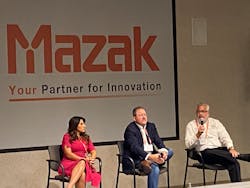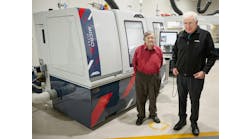RPM is also a family-owned business with around 50 employees in Arcadia, Ohio. “I’m second generation,” explained Metcalfe. “I work with two of my daughters and a son-in-law. The grandkids come in on the weekends to empty trash cans, so we’re working on our fourth generation. We started in the Detroit area and moved to Ohio in 1969.”
RPM diversified out of automotive into aerospace and food packaging. “We try to stary spread out over the industries because everybody has those ups and downs,” said Metcalfe. “The challenge with that is you become a jack-of-all-trades and a master of none. We focus on high-precision work. We use Studer grinders, and our electric discharge machining (EDM) machines are Mitsubishi.” Faxon started in the family business, Faxon Machining, primarily a defense contractor in Cincinnati, when he was 13 years old. “We started in a 4,500-sq-ft building,” he noted. “Through a lot of different events, we have a holding company with a 15-acre campus. We’re just under 300,000 sq ft in two locations with 350 people now.”
Automated future
Adoption of automation is often slow and cautionary in any organization, but especially so in multi-generational ones where the founders are not only heavily invested in sweat equity, but are parents or grandparents of chief executives. “My challenge was my dad,” explained Wolter. “We’re high-mix, low-volume (HMLV). COVID spurred our need to automate. You couldn’t keep up with demand or with people who couldn’t be at work. We bought a RoboJob. I sold my dad on it.”
The next generation of workers in technology has different skill sets and different interests, said Wolter. “Not only are they working in robotics, but I can skill them up to do something more challenging,” she explained. “I plan to put more robots on mills. If someone doesn’t show up, cross-training has to be all over the board. I don’t believe in taking the blood out of the business. How do you keep the bodies, but also keep being lean? Robotics is the way to go. It’s getting people in and giving them the opportunity.” In addition to family members, companies often have to convince a board of directors or a bank, noted Faxon.
“When you break into automation, pick something where it fits,” he advised. “Make it a win out of the gate. Make sure that you put wins up front. There are times when Integrexes fit like a glove on the hand. But there are times when they don’t. Make sure your beachhead is solid.”
Despite worker worries about being replaced by automation, Faxon stressed the opposite is more likely.
“The factory of the future is going to pay your employees more,” he said. “You’re going to supply best value to your customers. Your ultimate goal should be to return highest shareholder value. I don’t look at it as reducing labor. A machinist should be able to wear a white shirt to work. Automation can be used throughout your whole shop, not just the operator, but wherever there’s a body. There are automation opportunities for indirect labor, as well as direct labor.”
At RPM, the challenge is the shop’s runs are short, so it’s constant changeover. “We’ve looked at a lot of automation,” said Metcalfe. “We put long-run jobs on in the evening, so it’s lights-out.” Further complicating the situation, as RPM grows, its workforce is retiring, so the focus is constantly on training. “We’re trying to utilize our people, but we’re going to have to implement more with robotics,” he explained.
Train, train, train
“We use journeymen to train our apprentices,” explained Metcalfe. “We try to bring in a young person and marry them up with a journeyman. Our people are our largest investment and our greatest asset.”
HM likes to bring in local high-school kids to maintain a stream of new employees. “There are three local high schools with robot programs,” explained Wolter. As they complete their training, they are all certified with the National Institute for Metalworking Skills (NIMS), she said.
“They all know Mastercam,” explained Wolter. At 16, a student can start a paid internship program with HM. “They do job shadowing, and then they can do an apprenticeship program for six or eight weeks, depending on school schedules,” she said.
“We have a busload of kids who come in every quarter,” said Faxon. “We’re hiring X amount of people, but we have 10X or 20X amount of people.” The number of existing staff is proportionately higher, and they need training and attention, too, he stressed.
“Hiring people is necessary, but how many engineers are sitting there unmotivated? How many are feeling neglected and overlooked because we’re looking at new talent? Don’t forget the people who are there. Every person in our company has more to offer than they’re currently doing,” emphasized Faxon.
Where the supplies are
In the wake of the strangled supply chain, many companies are still looking for solutions to improve the availability of materials and secure manufacturing capabilities at a local level, despite global influences. Price point, however, remains a hurdle that is difficult to clear when faced with consumer or shareholder pressures.
“I am very partial to domestic manufacturing,” stressed Faxon, who noted it’s sometimes difficult to decouple economic issues from other country’s labor values. Other countries are emerging from using Bridgeport milling machines, he said. “The playing field has leveled. If I have high technology and they have high technology, our challenge is to give people the option to bring manufacturing back,” explained Faxon. “But don’t fool yourself: There’s a dollar sign assigned to this decision.” Because RPM is spread out over a number of industries, many of its competitors are overseas. “People here in the United States are on equal footing, and it’s starting to become like that with foreign competitors,” said Metcalfe. “We’re being forced to compete on that global stage.”
HM’s lot sizes have changed, which has forced Wolter to rethink what the job shop is doing. “One-piece or two-piece takes too much time,” she cautioned. “I need to look at the future. All of the data points are about time. Every two years, we replace or buy a new piece of machinery. When we get crazy parts from aerospace and defense, we’re ready to go.”






